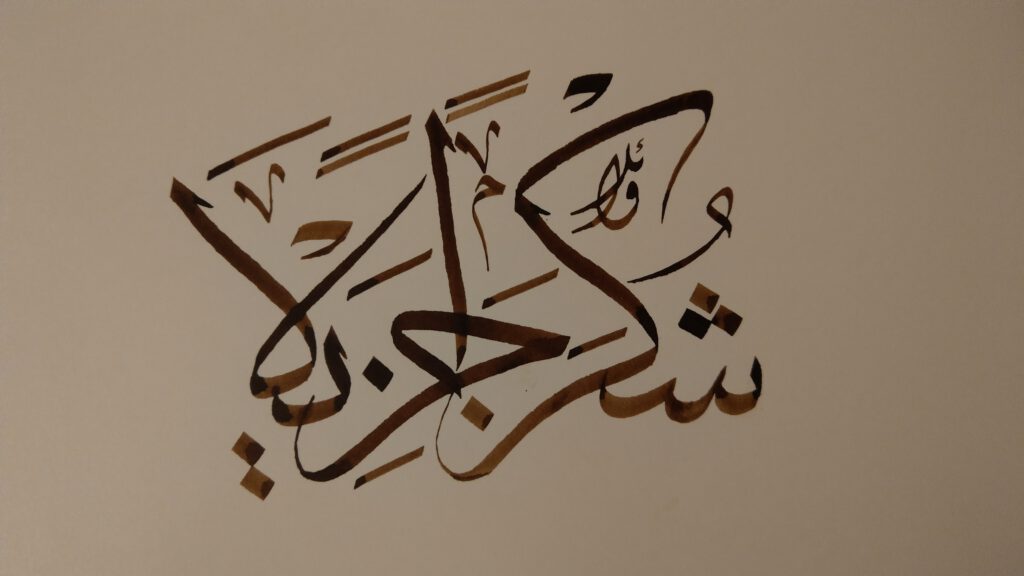
shukraan jazilaan
Ein wunderschön kalligrafiertes arabisches “Danke sehr” in Thuluth-Schrift, einer der kursiven Schreibstile, die auf der geschwungenen Naschi-Schrift basieren. Charakteristisch für die Thuluth-Schrift sind die großen Oberlängen ihrer Buchstaben sowie ihre schwungvollen Endungen, sie findet sich häufig als Zierschrift auf Moscheen und anderen Gebäuden. Gemeinsam mit der eckigen Kufi-Schrift bilden die Naschi-Formen die Hauptstilrichtungen der arabischen Kalligrafie. Als eine der wichtigsten Kunstrichtungen des Islams gehen die Ursprünge der arabischen Kalligrafie auf die Zeit 650–660 n.Chr. zurück, zu ihrer Vollendung gelangte sie während des Osmanischen Reichs.
Das arabische Alphabet besteht aus 28 Buchstaben. Im Zentrum der arabischen Kalligrafie steht die innige Auseinandersetzung der Gläubigen mit den Versen des Koran. Kalligrafie wird hier zum ästhetischen Ausdruck praktizierter Religion, indem die Schönheit der Schrift versucht, der Schönheit des Wortes nahezukommen.
Für sein “Danke sehr” hat Wael Kayyali einen Bambusstift verwendet, Qalam auf Arabisch, als Tinte benutzte er Edelstein (Smoky Quartz) von Pelikan.
Weitaus mehr als kunstvoll geschriebene Worte
Arabisch ist Wael Kayyalis Muttersprache. Er ist Syrer und kam 2015 nach Deutschland. Die Zeit, in der er auf seine Deutschkurse wartete, hat er dazu genutzt, Kalligrafie zu lernen. Er liebt Buchstaben und ist überzeugt, dass die geschriebene Sprache mit zum Kreativsten gehört, das Menschen je entwickelt haben. Zurzeit studiert er an der Bergischen Universität Wuppertal und arbeitet als selbstständiger Kalligraf.
Wer für das Wenige nicht dankbar ist, der wird auch für das Viele nicht dankbar sein,
Prophet Mohammed
und wer den Menschen nicht dankt, der dankt auch Allah nicht.
Wir danken Wael Kayyali sehr herzlich für seinen Beitrag und wünschen Ihnen viel Freude mit seiner Gestaltung:
Wael Kayyali (PDF)
shukraan jazilaan
A beautifully calligraphed Arabic “Thank you very much” in Thuluth script, one of the italic writing styles based on the curved Naschi script. Characteristic of the Thuluth script are the large ascenders of its letters as well as its sweeping endings. It is often found as an ornamental script on mosques and other buildings. Together with the angular Kufi script, the Nashi forms are the main styles of Arabic calligraphy. As one of the most important art forms of Islam, the origins of Arabic calligraphy go back to the period 650-660 A.D., and it was completed during the Ottoman Empire.
The Arabic alphabet consists of 28 letters. At the centre of Arabic calligraphy is the intimate confrontation of the believer with the verses of the Koran. Calligraphy here becomes the aesthetic expression of practiced religion in that the beauty of the writing tries to depict the beauty of the word.
For his “Thank you very much” Wael Kayyali used a bamboo pen, Qalam in Arabic, and the ink is gemstone (Smoky Quartz) from Pelikan.
Far more than artfully written words
Arabic is Wael Kayyali’s mother tongue. He is Syrian and came to Germany in 2015. He used the time waiting for his German classes to learn calligraphy. He loves letters and is convinced that the written language is one of the most creative things people have ever developed. He is currently studying at the Bergische Universität Wuppertal and works as an independent calligrapher.
He who is not grateful for the little will not be grateful for the much,
Prophet Mohammed
and he who does not thank men will not thank Allah either.
We thank Wael Kayyali very much for his contribution and wish you much pleasure with her design:
Wael Kayyali: thank you (PDF)